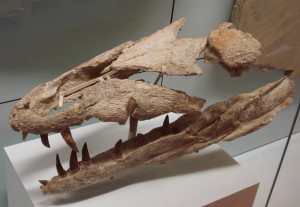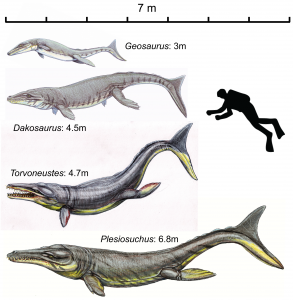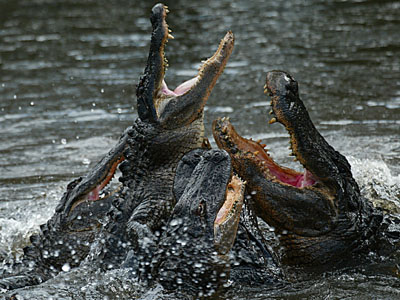When you cast your mind back to the Mesozoic and think of the predators of the time, your mind goes to dinosaurs. You just thought of a T. rex didn’t you? Didn’t you. Crocodiles are the unsung heroes of the past, probably due to the fact that they’re still around today, so not considered as exotic as many of the extinct species we all know and love. But how similar were they to modern species? Or, how different were they? A new paper out in the open access journal PLoS ONE (which means you can read it for free!) looks into how a pair of ancient crocodile species from the Late Jurassic used to nosh the local residents. You’ll have to cast your mind back around 150 million years to a time when Europe was once a sea, teeming with creatures weird and wonderful, most of which now would see you as nothing more than a bipedal snack.

Dakosaurus maximus skull from the Staatliches Museum für Naturkunde Stuttgart (click for larger image). Source: Wikipedia (Ghedoghedo)
The crocodiles the group led by Mark Young (Edinburgh University, UK) looked at are of a group known as metriorhynchids, or as I prefer to call them, meteorhynchids. Much cooler sounding. These were pelagic organisms living in the sea, and had many adaptations suited to this lifestyle including paddle-like forelimbs, a strong rudder tail, large salt glands, and a complete loss of their bony back armour (osteoderms). Species belonging to this group fall into two sub-groups, each with a range of different morphologies, and with that, various behavioural ecologies. Most of the paper is taken up in monograph-style redescription of two particular species that lived in the same time and place (contemporary sympatrics), Dakosaurus maximus (I want two subspecies to be named decimus and meridius) and Plesiosuchus manselli, and a helluva lot of related material, which is far too boring detailed to fit into any blog post. The cool stuff comes after wading through a sea of descriptive terminology.

Yikes! Some isolated fossil teeth of Dakosaurus maximus, showing wear patterns and damage due to feeding. (bf: basal facet, btc: broken tip, cw: carinal wear; click for larger image). Copyright: Young et al 2012
Both the aforementioned species have quite distinct, or disparate, overall morphologies. There’s a host of weird and frankly unnecessary jargon to describe this. For example, Dakosaurus has an ‘amblygnathous’, which just means bullet-shaped (when looked at from above, or dorsally) and oreinirostral (tall, convex from above) snout. Plesiosuchus was quite different, as you can see in the reconstructions shown below. Looking at this morphology, and in detail at the teeth, the study concludes that both had distinct predatory styles.

Later reconstructions of the skulls of Plesiosuchus manselli (A), Dakosaurus maximus (B) and Dakosaurus andiniensis (C) (click for larger image). Copyright: Young et al 2012
Dakosaurus predated like a modern killer whale; adapted for chomping on large fleshy prey, or macrophagy. They had tiny serrated ridges, or denticles, lining their teeth, designed for slicing and dicing their prey, as modern sharks and whales do. This is an adaptation to increase energy efficiency, as it becomes easier to penetrate food, increasing consumption and making larger prey more targetable. No one is safe. The fossilised teeth of Dakosaurus also show signs of spalling, where the outer layer is almost chipped off by contact with a hard substrate, like a bone. Killer whales exhibit this feature (but then, so do sticklebacks as well), which suggests that they fed on similar prey, such as tough-skinned chondrichthyians. Coupled with a pretty robust skull designed for resisting the stresses of hunting, the morphological evidence suggests that Dakosaurus used to dine on large prey.
Plesiosuchus is a different tale entirely. The teeth exhibit no wear or spalling patterns, no denticles, and the overall design of the skull was much mechanically weaker. This is the beginning of the unravelling of how two pretty hefty predators were able to coexist, in a similar fashion again to modern killer whales, which exist together as distinct types separated by feeding style. If the range of shared characteristics between these prehistoric beasties and killer whales are indicative of comparable ecology, then it appears Plesiosuchus would have been a specialist feeder (eating other marine reptiles), and Dakosaurus was probably a generalist, or even suction-feeder, based on convergent skull form with the cetacean Janjucetus. If this latter point is valid, then Dakosaurus species would have been the first suction-feeding marine crocodylomorphs. Cool!

Reconstructions of some metriorhynchid species, and crunchy human for scale. These are all from the Late Jurassic of Western Europe. Maximum body lengths are shown (click for larger image). Copyright: Young et al 2012
That’s not all though. The seas at this time where absolutely teeming with predatory reptiles, it seems. The opthalmosaurid ichthyosaur Brachypteryguis was pretty big, as well as the small matter of three different giant pliosaur species. This raises the key ecological question of how so many large predators from different groups were able to coexist together. The clues again come from modern whales of the toothed variety (odontocetes, including sperm whales, dolphins, and beaked whales). In the Bay of Biscay, there are nine sympatric deep-diving odontocetes, that sub-divide eco-space (I’m not going to use the phrase ‘ecological niche’, as it’s one of the most loosely defined terms in science) according to four criteria: prey size, prey quality, prey type, and depth. This pattern is also similarly replicated by the local sharks (conformists). It seems like this may be the scenario mimicked 150 million years ago by the marine reptiles of the time, based around the concept of resource demand and acquisition.
Do you think this is simply the natural order of things, or something that populations of organisms had to learn and develop through time?
Moral of the story: if a 150 million year old crocodile invites you to dinner, you have to wash your hair that night.
Reference
Young, M. T. et al. (2012) The cranial osteology and feeding ecology of the metriorhychid crocdylomorph genera Dakosaurus and Plesiosuchus from the Late Jurassic of Europe, PLoS ONE, doi:10.1371/journal.pone.0044985 (free paper)

